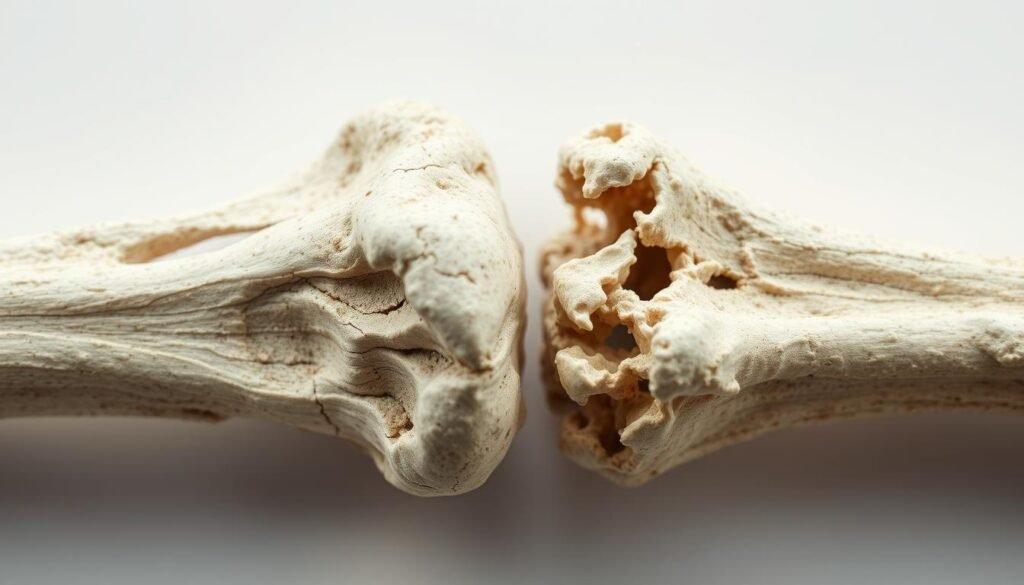Did you know our bones are always renewing themselves? This process takes about 10 years. However, many people don’t get the needed daily calcium. This is crucial for strong bones. Sadly, a lot of Americans, especially those over 50, don’t hit the calcium mark. This can lead to conditions like osteoporosis. We will explore calcium’s importance, its role in bone strength, how much we need daily, where to find it in our diet, signs you’re not getting enough, and the risks of not having enough of it.
Key Takeaways
- Calcium is crucial for maintaining strong bones and overall bone health.
- Many Americans do not meet the recommended calcium intake, particularly in older age groups.
- Calcium deficiency can significantly increase the risk of osteoporosis and bone loss over time.
- Dietary sources of calcium include dairy products, leafy greens, and fortified foods.
- It’s important to balance calcium intake with vitamin D to promote proper absorption.
Understanding Calcium’s Role in Bone Health
Calcium is key for strong bones and teeth. It’s a big part of our body, mostly found in these areas. It not only gives bones their hardness and structure but also helps our body in many ways.
What is Calcium?
Calcium is the body’s most abundant mineral. It’s vital for muscle movement, sending messages through the nervous system, and releasing hormones. We need a certain amount of calcium every day for healthy bones and overall function. Not getting enough can lead to weak bones and other health issues.
How Calcium Supports Bone Structure
Calcium plays a big role in bone development and keeping them strong. With enough calcium, kids and teens can reach their highest bone mass and adults can keep their bones dense. Low calcium intake can make bones weak, raising the risk of osteoporosis and breaks. It’s important to know how much calcium you need to keep bones strong. For tips on a bone-healthy diet, see this link.
| Age Group | Recommended Daily Intake (mg) | Upper Safe Limit (mg) |
|---|---|---|
| Birth to 6 months | 200 | 1,000 |
| Infants 7-12 months | 260 | 1,500 |
| Children (1-8 years) | 700-2,500 | 2,500 |
| Children (9-18 years) | 1,300 | 3,000 |
| Adults 19-50 years | 1,000 | 2,500 |
| Adults 51+ | 1,200 (females), 1,000 (males) | 2,000 |
Daily Calcium Requirements for Different Life Stages
Calcium plays a crucial role at different stages of life. It is key for strong bones and overall health. Each age group has its own calcium needs due to growth and body changes.
Recommended Intake for Children and Adolescents
Youngsters need lots of calcium. Infants 6 to 12 months should get 260 mg of calcium each day. Toddlers 1 to 3 years old need 700 mg daily.
From 4 to 8 years, children require 1,000 mg a day. Teens aged 9 to 18 need 1,300 mg to support their growth. These levels are key for their development.
Calcium Needs in Adults and Older Adults
Adults aged 19 to 50 need 1,000 mg of calcium daily. After 50, women and men over 71 need more—1,200 mg a day. This helps keep bones strong and prevents osteoporosis.
Osteoporosis affects many older Americans. Getting enough calcium can lower its risk. For more info, visit this source.
Common Sources of Calcium in Our Diet
Calcium is key for strong bones. It’s important to know where calcium-rich foods are found. This helps meet daily needs for good health.
Top Food Sources: Dairy Products
Dairy products are big on calcium, making up 72% of our intake in the U.S. An 8-ounce serving of plain, nonfat yogurt has about 488 mg of calcium, or 37% of what you need daily. Low-fat yogurt can give you 34% of your daily need. Parmesan has 19% per ounce, and Brie has about 4%. Eating these foods regularly helps keep bones and teeth strong.
Non-Dairy Calcium Sources
If you can’t have dairy or choose not to, there are other ways to get calcium. For instance, one can of canned sardines packs 27% of the daily value (DV). Three ounces of canned salmon with bones have 19% of the DV. Other great options include leafy greens like cooked collard greens and bok choy, offering 21% of the DV per cup. Also, foods like fortified cereals, cooked amaranth leaves, and seeds such as chia and almonds are good. To find more calcium sources, check out this webpage.
What Happens to Our Bones Without Enough Calcium?
Not getting enough calcium can really hurt our bones. Without enough, our bodies pull calcium from our bones to keep our blood levels right. This can lead to weaker bones and other health problems.
Effects on Bone Density
If we don’t get enough calcium, our bones get weaker. This can lead to a condition called osteopenia, which is when bones are less dense and fragile. If bones are weak, even a small fall can break them. It’s really important to eat enough calcium to keep our bones strong.
Potential Development of Osteoporosis
Not getting enough calcium for a long time can lead to osteoporosis, especially in older women. Osteoporosis makes bones very brittle. This means they can easily break. About half of women over 50 will break a bone because of osteoporosis. That’s why it’s so important to get enough calcium.

Calcium Deficiency Symptoms and Signs
Spotting signs of low calcium early is crucial for good health. You might start with muscle cramps or feel really tired all the time. If not noticed early, these mild signs can lead to serious calcium shortage.
Identifying Early Symptoms
Here are some symptoms to watch out for:
- Muscle spasms and cramps
- Numbness and tingling sensations
- Weak nails and brittle hair
- Pain in bones
- Dry skin and dermatological issues
- Depression and mood swings
If you ignore these early signs, they might get worse. Not acting on it can lead to dental problems, weak bones, and even brain issues.
Long-term Consequences of Low Calcium Levels
Not having enough calcium for a long time is bad for you. What could happen includes:
- Increased risk of osteoporosis and spinal fractures
- Potential for heart arrhythmias and decreased heart function
- Mental health issues, like depression and confusion
- Higher chance of hurting your eyes
- Seizures because your nerve cells aren’t working right
Eating foods high in calcium can limit these risks. Learn why calcium is important and how to keep your bones strong. For more, visit essential vitamins for bone health.
Risk Factors for Calcium Deficiency
Knowing risk factors for calcium deficiency helps us find who might need to change their diet or lifestyle. Some demographic groups are more at risk because of how their bodies work or where they live. Also, the lifestyle choices people make can affect their calcium levels and bone health.
Demographic Groups at Higher Risk
Certain demographic groups are in danger of not getting enough calcium. For example:
- Postmenopausal women lose bone density because of lower estrogen, putting them at higher risk.
- Older adults have trouble absorbing calcium. They need up to 1,200 milligrams daily after age 70.
- People who don’t eat much dairy might not get enough calcium, leading to a deficiency.
Lifestyle Choices Impacting Calcium Intake
Some lifestyle choices are key to maintaining good calcium levels. Let’s look at these factors:
- Not being active weakens bones, but exercises that make you bear weight can improve bone health.
- A diet low in calcium, often seen with low dairy intake, greatly adds to the risk of deficiency.
- Drinking too much alcohol and smoking can worsen bone loss and up the chance of fractures.
- Certain illnesses and medicines that mess with calcium absorption also threaten bone strength.

The Importance of Vitamin D for Calcium Absorption
Vitamin D is crucial for calcium absorption in our bodies. Without enough vitamin D, we can’t absorb calcium well. This can lead to problems with our bones. Vitamin D keeps calcium and phosphorus levels right in our blood. This is important for healthy bones and their density.
How Vitamin D Facilitates Calcium Use
Vitamin D plays a key role in calcium use. It makes our intestines absorb calcium better. This helps our bones stay strong. Studies reveal that people lacking vitamin D have poor calcium absorption. Their bone health suffers, raising osteoporosis and fracture risks.
Sources of Vitamin D
We need good sources of vitamin D to stay healthy. Common sources are:
- Sunlight exposure, which stimulates vitamin D production in the skin
- Fatty fish like salmon, mackerel, and sardines
- Fortified foods, including milk, orange juice, and cereals
- Egg yolks and cheese
Some people, especially in places with little sun, may need vitamin D supplements. This is true for older adults and those with certain diets.
| Source | Vitamin D Content (IU per serving) |
|---|---|
| Salmon (3.5 oz) | 570 |
| Mackerel (3.5 oz) | 345 |
| Tuna (canned, 3.5 oz) | 154 |
| Fortified Milk (1 cup) | 100 |
| Fortified Orange Juice (1 cup) | 137 |
| Egg (1 large) | 41 |
Preventing Calcium Deficiency through Nutrition
It’s important to keep your bones strong and health in check. Having a balanced diet full of calcium-rich foods helps avoid deficiencies. Eating dairy, green veggies, and foods with added calcium meets your daily needs.
Creating a Balanced Diet
A diet with various nutrients helps your body use calcium better. Important parts of this diet include:
- Dairy Products: Milk, cheese, and yogurt are packed with calcium.
- Leafy Greens: Spinach, kale, and collards are great for calcium and other nutrients.
- Fortified Foods: Some orange juice and cereals have extra calcium added.
- Fish: Salmon and other fatty fish give you calcium and vitamin D for better absorption.
Eating these foods is key to stopping calcium deficiency.
Supplements: When to Consider Them
If food alone doesn’t fulfill your calcium needs, calcium supplements might help. Remember, don’t take more than 2000 mg of calcium a day from all sources. This helps avoid bad side effects. Each supplement is absorbed differently:
| Supplement Type | Best Taken With | Notes |
|---|---|---|
| Calcium Carbonate | Low-iron meals | This is the least costly but needs stomach acid to work. |
| Calcium Citrate | Any time | It’s better absorbed without food and works well in big doses. |
Always talk to a doctor before you start taking calcium supplements. They can guide you based on your lifestyle and health.

Long-term Consequences of Calcium Deficiency on Bone Health
Calcium is key for strong bones. If you don’t get enough, serious problems can happen over time. Without enough calcium, you lose more bone as you get older. This can affect how well you move and feel. It’s important to understand this to stay healthy.
Accelerated Bone Loss and Aging
A lack of calcium can lead to osteoporosis, which makes bones weak and brittle. When bones get less dense, the body takes calcium from them for other needs. This makes bones even weaker. It’s worrying, especially for older people, because their bone health is at greater risk.
This weakening of bones can start a cycle where activity and independence decrease. This happens as older adults face more health challenges. That’s why getting enough calcium is very important.
Increased Fracture Risk and Impact on Mobility
Low calcium means a higher chance of breaking bones. Bones get frail, and even a small fall can cause a fracture. These breaks can make it hard to move around, reducing independence. So, not getting enough calcium can really lower life quality as you age.
Conclusion
Calcium deficiency is a major concern for bone health, affecting people at different ages. It’s important to know how vital calcium is. This knowledge explains the need for enough calcium in our diet or through supplements. This way, we can keep our bones strong and avoid osteoporosis.
In the US, the amount of calcium people take in varies. But, it’s key to be aware of common sources of calcium. For example, dairy products provide about 72% of the calcium in our diets. Knowing this can help us make better food choices.
Yet, many folks might not get the 1,000 to 1,200 mg/day of calcium that adults need. Lifestyle and certain risks can lead to not having enough calcium. This lack increases the risk of health problems. Understanding the signs and possible issues from not getting enough calcium is important. This helps people take the right steps to improve their health.
In short, getting enough calcium does more than stop short-term problems. It’s about keeping our bones healthy for our whole lives. By eating the right foods and possibly taking supplements, we can lower the risks related to not having enough calcium. This supports our overall health.